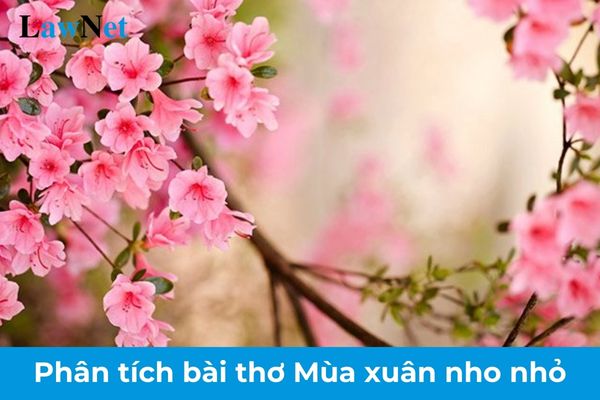What is the sample analysis of the poem "Mùa xuân nho nhỏ" for 9th-grade students? What are the assessment methods for subjects of 9th-grade students in Vietnam?
What is the sample analysis of the poem "Mùa xuân nho nhỏ" for 9th-grade students in Vietnam?
The poem "Mùa xuân nho nhỏ" by poet Thanh Hai is a work rich in emotion, deeply embedded with lyrical and profound significance. To analyze the poem "Mùa xuân nho nhỏ", we need to focus on its content, artistry, and symbolic meanings.
Below is a sample analysis of the poem "Mùa xuân nho nhỏ" for 9th-grade students in Vietnam:
|
Thanh Hai was a poet who matured during the period when the country was striving to resist the Americans. Immersed in the heroic rhythm of the nation, Thanh Hai had his own creations about the people and the country during this period. In 1980, when the country had been through heated resistance for 5 years and the poet was then lying on his sickbed, he wrote those pure-hearted and passionate verses about the country. This is a representative poem of Vietnamese poetry during this period: “Mua xuan nho nho”.
Utilizing personification and comparisons turns the country into a person: “hardship, struggle” conveys its steady, enduring, and bright spirit. The metaphor of the country as a star seems to reaffirm the nation's eternal brightness against time and the universe. Through the stanza, one can see faith in a broad, solid future, the unwavering confidence of entering a new century, an era of freedom, independence. Let me be the singing bird The author wishes to be a singing bird to offer clear resonant tunes, wishes to be a flower twig to offer fragrance to life. The author also wishes to be “a poignant low note” in life’s symphony, silently bringing pure sounds into harmony. The poet's simple wish reflects a beautiful life concept, responsibility to communal life. A little spring For the author, his spring is “a little spring” contributing to the great spring of the country. That spring remains “silent,” quietly devoted with love, enthusiasm, modesty, silence. The repeated phrase: “whether” along with the metonymy in the last two lines “twenty years” symbolizing youth, “silver hair” symbolizing old age. At any stage, the author aspires to contribute. Thanh Hai's verses serve as a summary of his life, evoking emotional associations for readers and steeped in humanistic philosophy. The final stanza is a tribute to the country: Spring – let me sing Intensely fierce emotions erupt into a beloved, proud song in the voluntary melody of his homeland Hue. One must be a person dedicatedly, lovingly living, a soul brimming with life force to sing a praise from life like Thanh Hai. That song stays with time, with the country, defying all natural laws of impermanence. The poem “Mua xuan nho nho” in the five-word verse form associated with folk tunes suitable for expressing emotions has painted an entire picture of the spring of nature, the spring of the country. The poem’s rhythm and tone align with the author’s eager and passionate emotion, making it hard for readers to believe these are the verses of one nearing the end of life. The country increasingly progresses, the spring of the country grows ever more beautiful, but the verses “Mua xuan nho nho” continue to transcend time because it not only reflects Thanh Hai's emotions but also impart profound humanistic lessons. |
Note: Content is for reference only.

What is the sample analysis of the poem "Mùa xuân nho nhỏ" for 9th-grade students? What are the assessment methods for subjects of 9th-grade students in Vietnam? (Image from the Internet)
What are the assessment methods for subjects of 9th-grade students in Vietnam?
Under clause 3, Article 5 of Circular 22/2021/TT-BGDDT, the assessment methods for subjects of 9th-grade students in Vietnam are as follows:
- Conduct assessment for: Physical education (PE), Art, Music, Fine Arts, local education subjects, experience learning activities, and career counseling; learning results of subjects shall be categorized as “Đạt” (Qualified) or “Chưa đạt” (Unqualified).
- Conduct assessment based on both feedback and scores for subjects in formal education program, except for those under Point a of this Clause; subject-based learning results shall be given in a total of 10 scores, any other form of scores must be converted to 10-score model. Assessment score must be an integer or a decimal number rounded to the nearest tenths.
What are the assessment levels of learning results of 9th-grade students in Vietnam?
According to clause 2, Article 9 of Circular 22/2021/TT-BGDDT, the assessment levels of learning results of 9th-grade students include:
1) Excellent:
- All subjects assessed with feedback are placed in Qualified category.
- All subjects assessed by both feedback and scores have minimum scores of 6.5 for DTBmhk and DTBmcn with 6 subjects among which have minimum scores of 8.0 for DTBmhk and DTBmcn.
2) Good:
- All subjects assessed with feedback are placed in Qualified category.
- All subjects assessed by both feedback and scores have minimum scores of 5.0 for DTBmhk and DTBmcn with 6 subjects among which have minimum scores of 6.5 for DTBmhk and DTBmcn.
3) Qualified:
- Have no more than 1 subject assessed via feedback placed in Unqualified category.
- At least 6 subjects assessed by both feedback and scores have minimum scores of 5.0 for DTBmhk and DTBmcn with 0 subjects have scores lower than 3.4 for DTBmhk and DTBmcn.
4) Unqualified: Remaining cases.

